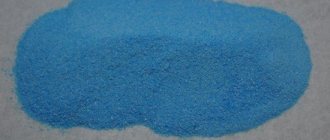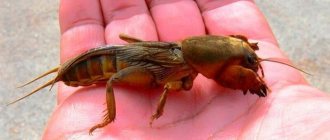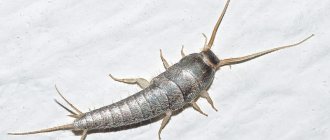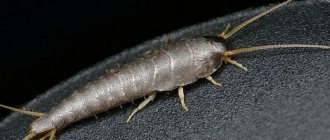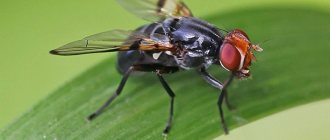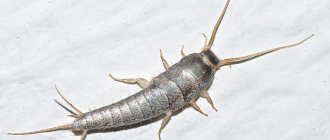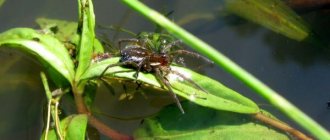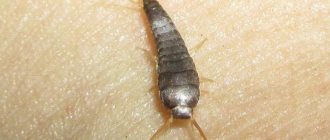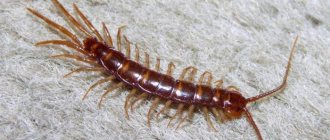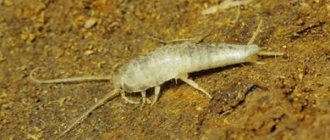Common silverfish (sugar silverfish, lat. lepisma saccharina) lived on earth three hundred million years ago. They belong to the phylum Arthropods and the order Bristletails. Now these insects are often found in apartments. They get into the house from products containing starch and polysaccharides. They do not pose any harm to human health.
Silverfish: photo
Silverfish living in the house.
Harm of silverfish to humans and animals
Directories boldly classify silverfish as pests. But what threat can these insects pose directly to humans? Let's get a look.
Silverfish do not bite, they do not attack people or animals, they are even completely indifferent to a sleeping person - they do not crawl into the bed, they do not take up residence in pillows. This type of insect is completely unsuited to carrying pathogenic bacteria or any infectious agents.
Then what is the harmfulness of silverfish?
As we have already found out, these insects eat polysaccharides: flour, starch, sugar. Therefore, the following are at risk:
- Products. Silverfish not only feed on household supplies, but also leave waste products in them: excrement and scales.
- Paper. A silverfish is unlikely to be able to completely eat a book or photograph, but the passages it gnaws can destroy an important piece of information. Then the book or photo album will still be hopelessly damaged.
- Household and interior items. Starch, which is part of laundry or wallpaper paste, can saturate silverfish for a long time. To get to the nutritional component, an insect can spoil both fabrics and wallpaper, and much more valuable things. For example, a unique painting or an antique souvenir.
- Mood. The unexpected appearance of a multi-legged insect in the house is unlikely to cause positive emotions, as well as signs of its presence in the home: holes in favorite things and foreign debris in food.
Photo gallery: risk of damage to premises by silverfish
Feeding on kitchen supplies, silverfish litter them with excrement and scales.
The insect won't be able to crawl high, but it will still be able to ruin the wallpaper.
Silverfish can cause damage to an expensive photograph or an ancient tome
Important: the appearance of silverfish in a house or apartment can serve as a signal about the poor sanitary condition of the home.
Description of the pest
Name: Common or sugar silverfish Lat.:
Lepisma saccharinaClass: Insects - Insecta Order: Bristletails - Zygentoma Family: Silverfish - Lepismatidae
| Habitats: | wet parts of the house |
| Dangerous for: | products, paper, interior items |
| Means of destruction: | traps, unpleasant odors, chemicals |
There are about 190 species of silverfish. About 10 species live in temperate latitudes. The insect resembles a flycatcher, although the latter have longer legs. Many scientists believe that the homeland of insects is the tropics.
Ideal conditions for reproduction are considered to be a humidity of at least 75% and a temperature of 21 to 26 degrees Celsius. In front of the silverfish there is a pair of long whiskers. The posterior part is characterized by three tail filaments. Insects don't have wings. They are nocturnal.
Pests are afraid of bright lighting. When exposed to light, they seek shelter. They move in quick dashes, sometimes making short pauses. When the temperature drops below 5 degrees Celsius, they go into suspended animation. At temperatures of 10 degrees below zero, larvae and adults die.
Kitchen treatment
We talked about what to do if sugarfish are in the bathroom. How to deal with these insects if they have taken a fancy to the kitchen? First of all, consider whether you want to put your household at risk by using chemically active substances. You know how to get rid of silverfish in an apartment using an aerosol or gel, but using them in close proximity to food is quite dangerous. For such a place it is better to use traps. You can entrust the destruction of sugar silverfish to professionals by purchasing suitable devices in the store. However, nothing prevents you from resolving this issue on your own. Moreover, it is not so difficult.
The silverfish is a fairly trusting insect. To attract him, you can use a regular jar, inside of which you place an apple core or a piece of sugar. The container should be wrapped in paper, securely secured with tape. Overnight, such a remedy for silverfish in an apartment can collect a lot of parasites. If the problem is large-scale, it is worth using several traps at once, installing them in places where pests are most concentrated.
Another option for how to get rid of sugar silverfish in the kitchen is based on the insects’ love for moisture. Roll up several damp sheets of newspaper and place on the floor. In the morning, take this paper and immediately take it out of the house. If the roll has dried out, it is better to burn it. You cannot turn it around, otherwise the trapped pests will scatter again. This method is also suitable for those who want to get rid of silverfish in the bathroom without using poisons.
Life cycle
The insect's lifespan is about 3 years.
Development speed
One generation develops over several months in nature. As temperatures rise over a couple of months, individuals appear that can develop and mate.
Starting a family
To increase the population, about 10 representatives are needed. Together they can create a family and lay eggs. The eggs are white. They have an oval shape. The size does not exceed 1 mm.
Formation of eggs
As they form, the eggs become darker with a brown tint. The duration of egg maturation at a temperature of 20 degrees Celsius is about 40 days, and at 30 degrees Celsius - 25 days.
Appearance of larvae
The second stage of development is characterized by the absence of scales. They appear after the end of the second molt. Molting occurs 5 times in larvae and throughout life in adults.
How to get rid of silverfish
Effective control of insects can be carried out in various ways. The choice of method depends on the convenience and characteristics of the situation.
There are two most effective types of homemade traps for catching silverfish:
- In the first option, take a jar with a capacity of about a liter. The outside should be wrapped with electrical tape or masking tape, this is done so that insects can easily climb inside along the surface. There is bait inside, it could be a piece of sugar from their bread. The point is that pests will not be able to get back through the smooth walls of the jar.
- A newspaper or a stack of paper is rolled up and moistened with water. In this form, it is placed overnight in places where insects accumulate. During the night, the silverfish will penetrate the newspaper, and all that remains is to take it outside, or, even better, burn it.
You can also effectively use absolutely harmless insect repellents:
- Boric acid. The product is not harmless. It is dangerous if inhaled by both humans and pets. But at the same time, spraying problem areas with boric acid kills absolutely all insects. It should only be used using personal protective equipment.
- Dialomite powder. It’s not the most common remedy; it’s safe to say that many have never heard of it. This substance is also called mountain flour; it is made from rock. The product is harmless to humans and animals. The peculiarity is that the particles have sharp edges, therefore, after the particles are absorbed, the insects are injured from the inside.
- Citrus zest. Its smell is extremely unpleasant for silverfish, and they themselves will leave the place saturated with this aroma. The method, although long, is very effective and absolutely harmless, of course, provided that the person is not allergic to citrus fruits.
- Surviving unwanted guests from the kitchen is also quite simple; for this, absolutely harmless spices are used, such as cinnamon, cloves, and essential oils. Using this method is completely safe for stored products, but very effective.
Aphids on roses: 7 effective methods to combat them
Types of silverfish
Common silverfish.
The main varieties include:
- ordinary or sugar - may have a gray, whitish, yellowish or light green tint. Females are not fertile. The maximum clutch during life is 10 eggs;
- home - size up to 12 mm. The color is brown or greenish. Laying up to 40 eggs. Usually settles in the kitchen;
- comb - an inhabitant of the Crimea;
- ant - settles in an anthill, feeding on the sweet drops of ants.
Habitat
Common silverfish choose moist and dark places as their habitat. In nature, they live mainly under fallen leaves, snags or stones. Moist and warm places are chosen on the territory of houses, as a rule, they settle in bathrooms. Due to the structure of their body, they cannot rise above the second tier, so they most often live on the ground or on the floor. Common silverfish will not survive in dry, bright areas.
The activity of these species occurs at night, and they spend daytime in the dark. There is an assumption that the genus of silverfish comes straight from the tropics, since they have the best conditions for existence there. Also, common silverfish are extremely fast.
Diet
Silverfish feed on foods containing proteins, starch, and sugar. The food system is able to digest cellulose, which is the basis of paper. The pest is capable of eating wallpaper, starched fabric, and plant remains.
Silverfish are not capable of biting humans or animals.
Silverfish close-up.
They don't try to get onto the pillow or bed. Insects do not carry bacteria or their pathogens. They cause damage:
- food - they eat household supplies and leave scales with excrement;
- paper products - they can chew through books and photographs, which can lead to the destruction of important information;
- interior and household items - are saturated with starch, which is found in wallpaper paste or in the composition of laundry treatment substances. May damage fabric, wallpaper, paintings, souvenirs.
Why is silverfish dangerous? What harm does it cause?
Silverfish, contrary to popular belief, do not pose a threat to humans. It does not carry diseases and does not bite or sting. Thus, the insect does not pose a serious danger.
With a small number of individuals, silverfish practically do not spoil things, that is, they do not interfere with the owner of the house in any way.
But still, this insect is considered to be a pest. This is justified by the following facts:
- The silverfish population is rapidly increasing, so the damage is becoming more noticeable. These insects chew through packages and damage books, linen and curtains. They can also further worsen the condition of old wallpaper or rotten wood.
- Laying eggs and remaining adults in human food. Although silverfish are not carriers of diseases, they can reduce the quality of food to the point where it becomes completely inedible. In addition, the pest, constantly moving, collects dirt and dangerous microorganisms on its own body. It can be dangerous if it gets into human food.
- The appearance, abundance and rapid movement of silverfish irritate people. The insect sometimes gets into the bed, inside the refrigerator, into the sugar bowl or other places. This makes people very nervous, disgusts them, ruins their sleep and reduces their performance.
This pest, despite being picky about living conditions, is highly resilient. Destroying a population that has settled somewhere is quite problematic. This is another reason why the insect is classified as a pest. This survival of silverfish is justified by the fact that it is most likely the ancestor of modern insects. Judging by the remains found, the pest has existed for about 400 million years. This fact is the main indicator of the survivability of this insect.
It is believed that silverfish are most dangerous for museums and libraries. In these places there is a lot of food, which is valuable for the insect, as well as various cracks and dark corners. For this reason, both museums and libraries follow strict rules regarding indoor humidity levels.
Reasons for the appearance of silverfish
High humidity is the only cause of pest invasion. They enter the room from:
- ventilation pipe - this is how most of all insects get in;
- cracks, cracks, windows and doors that are not tightly closed - the miniature size facilitates unnoticeable penetration;
- foreign objects - food, boxes from the basement, books, fabrics.
Silverfish in the house.
Where do silverfish live at home?
For the first time, insects come across the eye most often completely by accident. To accurately assess the situation with parasites, it is necessary to examine certain areas of the apartment. To do this, it is important to know where silverfish live at home. Most often this is:
- The space under the sink, toilet, washing machine.
- Places where water and sewer pipes pass.
- Under rugs in the bathroom and toilet.
- In the laundry basket if it is in the bathroom.
- Under and in the kitchen sink.
- In the drawer under the sink, where most often there is also a trash can.
- In drawers where food is stored.
- Under and behind the refrigerator.
For a comfortable existence, silverfish need:
- Available food sources.
- Humidity.
- Warm.
The combination of these three factors determines exactly where the beetle will live.
If suitable conditions exist not only in the bathroom and kitchen, then the insect can penetrate onto the balcony, into the living room, and into the pantry. The main reason why silverfish appear is either an accident, when you yourself brought insects along with new things or products into the house, or unsanitary conditions in public areas of the house or among neighbors, when parasites come through ventilation or along walls from other infected rooms.
Fighting methods
Some tips for fighting:
- dry the premises, since dryness and heat do not make it possible to survive, humidity should be no more than 30%;
- Using a solution of water with cloves, citrus, and lavender will help. Spray from a spray bottle once every 7 days;
- chemicals used include boric acid, pyrethrin, bleach, and copper sulfate;
- set traps in the form of a glass jar, wet paper, mechanical devices to catch cockroaches; leftover food is suitable for bait.
Cleaning books
The most difficult thing is when insects live in books or other valuable things. Chemical treatment against silverfish will not work in this case. However, this situation is not hopeless. It is enough to follow the following sequence of actions:
- The fight against silverfish in an apartment begins with packing items in hermetically sealed bags or plastic containers. All things must be dried thoroughly. Before closing the bag, the air is completely squeezed out.
- Leave the packages in the freezer for several days.
- After the required period has passed, remove the items from the freezer and containers. Wait until they reach room temperature. If you need to remove sugarfish from old books, carefully turn the pages and remove dead insects with tweezers or a brush. If the item is not worn out, just shake it well. It is also better to store valuables in the future in containers or bags.
If you have silverfish in your apartment, getting rid of them is not so difficult. By following a few simple preventive rules, you may never encounter such a problem at all. You will find more information on this topic on our website. Consultants of our company in Moscow will tell you how to get rid of sugar silverfish in the shortest possible time and with minimal financial costs.
Source
